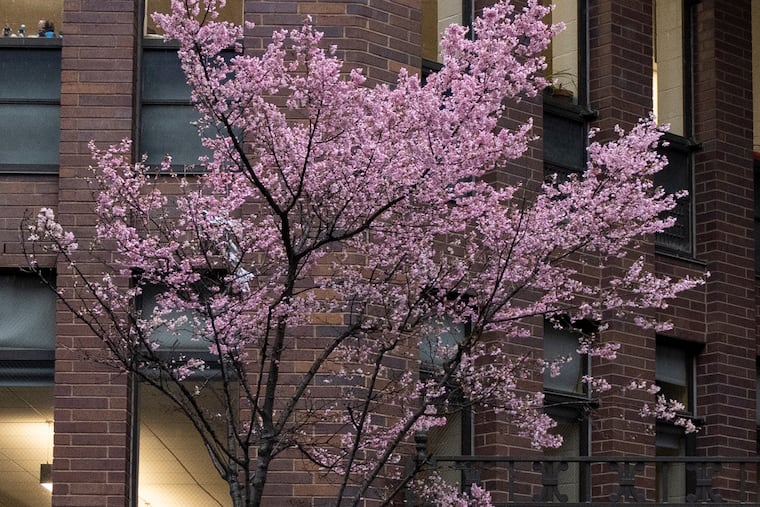‘Spring’ has arrived at its earliest in Philadelphia in at least 40 years as trees bloom and plants pop
February, which averaged 42.7 degrees, was second warmest on record for Philly dating back to 1875, according to the National Weather Service.

George Coombs, director of horticulture for the Mt. Cuba Center, a botanical garden near Wilmington, noticed two weeks ago that stems of trillium, a native wildflower, were already pushing up from rhizomes spread below the soil.
“Normally this time of year trillium are just kind of barely noticeable moving up out of the ground,” Coombs said. “But we have lots of trillium that are already kind of moving up out of the ground. Their leaves are unfurled. They’re green. They’re not quite blooming yet, but they are certainly way ahead of schedule by about three to four weeks.”
Though spring officially arrives with the equinox on March 21, it has already sprung for plants and birds in the region because of the unusually mild winter, experts say, with implications for everything from the timing of food for birds to how long you suffer from allergies.
Consider:
February averaged 42.7 degrees, the second warmest on record for Philly dating to 1875. The warmest, 2017, averaged 44.18 degrees.
January averaged 43.27 degrees, the third warmest ever and just barely behind second warmest of 43.29 average temperatures reached in 1932.
Philadelphia recorded virtually no snow those two months, when normally it would have seen 15.5 inches.
The result: Plants were primed to pop.
Mt. Cuba Center has thousands of species of trees, plants, and flowers across its 1,008 acres, and many are also ahead of schedule because of the unusually mild winter, combined with the lack of any appreciable snow in the Philadelphia region. Some species are in bloom that typically don’t arrive until April.
Coombs called the early arrivals of plants “alarming” and consistent with climate change and wonders about the long-term effect on flora and fauna.
“I was just walking in the garden this morning,” Coombs said during an interview Wednesday. “And to me, the garden looks today more like it would look normally on April 1.”
Members of the Philadelphia America’s Garden Capital, a group that promotes horticultural centers in the region, have reported similar early emerging plants, according to a wrap-up provided by the Mt. Cuba Center. Bowman’s Hill Wildflower Preserve in New Hope, the Scott Arboretum of Swarthmore College, Welkinweir near Pottstown, and others are seeing numerous bulbs blooming early or reaching peak far ahead of schedule. The Scott Arboretum has opened its community garden plots a month early as a result.
The Grounds for Sculpture in Hamilton, N.J., reports that while it is not too far ahead of normal bloom, the mild winter allowed it to plant bulbs and pluck ivy that would have been difficult in other years.
Phenology
“It’s early on the East Coast, and in some cases, really extremely early,” Alyssa Rosemartin, an ecologist with the National Phenology Network, said of leaves emerging on some plants. “In the Philadelphia area, it’s the earliest on record for some locations. It’s dramatic this year, with leaf-out arriving weeks, or even a month, ahead of when we normally see activity.”
It’s just barely ahead of 2017.
Phenology refers to the cycle of plant and animal life — sort of a natural calendar that marks when cherry trees bloom or robins build nests.
The National Phenology Network has data going back to 1983 for its “First Leaf Index” based on when lilac and honeysuckle emerge. The network reports that many spring events are occurring earlier while fall events are happening later than in the past. Not all species can change at the same rate, leading to mismatches in how they respond.
“If it is warm and mild and the plants get moving early, and then there’s a big freeze event, that can damage the plant tissue,” Rosemartin said. “That can have huge economic repercussions for agriculture.”
Farmers and gardeners depend on plant and insect cycles to decide how to avoid frost and when to plant and to apply fertilizers.
Meanwhile, birds rely on caterpillars to feed their chicks. Mismatches between when birds migrate and caterpillars emerge can cause food shortages for the babies. Other animals, such as snowshoe hare, rely on changing color from white to brown to protect themselves from predators. Mismatches make them more vulnerable.
What about Philadelphia’s cherry blossom festival?
The Japan America Society is hosting its free annual Subaru Cherry Blossom Festival of Greater Philadelphia on April 15 and 16, regardless of where the trees are in their life cycle.
Giulia Ciofini, a spokesperson for the society, said the date for this year’s festival won’t change, even if blooms are past peak because it is part of Sakura Weekend, a celebration of Japanese arts and culture at West Fairmount Park’s Horticulture Center & Centennial Arboretum.
“We still expect a big crowd to show up at the Sakura Weekend,” Ciofini said, noting that the cherry blossom festival has been held with no blooms in past years.
Peak bloom usually falls between late March and early April.
“We’re discussing holding future cherry blossom festivals no later than April 10,” Ciofini said, noting that blossoms can last one to two weeks depending on the weather. However, Easter, which falls on April 9, prevented organizers from holding Sakura Weekend earlier this year.
» READ MORE: Spring is arriving earlier, and getting warmer in Philadelphia
Climate Central, a nonprofit group of scientists and journalists, notes that the average temperature this February was 6.8 degrees above normal for Philly and that the month is getting warmer with an average increase in temperature of 5.3 degrees since 1970.
On the plus side, Climate Central says, Philadelphia has on average 32 more “freeze-free” days since 1970, suggesting a longer growing season. But that also means a longer allergy season.
This story has been corrected to note that the Mt. Cuba Center has 1,008 acres of land, not 7.